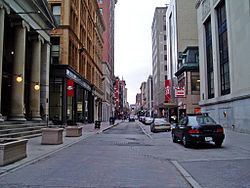Country United States County Providence County Zip code 02903 | State Rhode Island Area code(s) Area code 401 | |
 | ||
City Providence, Rhode Island | ||
Chinatown providence top 5 facts
The US city of Providence, Rhode Island was once home to at least two Chinatowns, with the first on Burrill Street in the 1890s until 1901 and then around Empire Street around the late 1890s in the southern section of the city. According to another source, the Burrill Street Chinatown was burned to the ground in 1901 by a "mysterious fire" caused by a kerosene stove.
Contents
The Empire Street Chinatown was considered one of the "last of the old Chinatowns" in a grouping that included Boston, Philadelphia and Baltimore. The extension of Empire Street, proposed in 1914 (according to the Providence Sunday Journal) and completed around 1951 doomed the Chinatown, and all of the buildings were demolished including the former headquarters of local Chinese societies. The enclave was once located next to the Empire Theatre and the Central Baptist Church.
History
Providence's Chinatown was built in the late 1800s, and disappeared sometime after 1951 according to a historical record of Patrolman Robert Chin, who is notable for being the country's first Chinese-American police officer. He "was raised at 136 Summer Street during the final years of the neighborhood's Chinatown settlement. His parents operated the Far East Noodle Company, which supplied local Chinese restaurants."
Another source said that Chinatown began as a community of Chinese grocery stores, restaurants, boarding houses, and laundries around the early 1890s along Burrill Street where the Blue Cross/Blue Shield building stands today. The Chinese Exclusion Act of 1882, a law which disfavored the Chinese race caused the decline of the Chinatown as future immigrants from China were prevented from coming causing the population of the Chinese race within the city to dwindle, along with the rest of the nation, in what was known as the "Yellow Peril." The neighborhood was forced to relocate to nearby Empire Street between Washington and Westminster Streets as development occurred, causing much of the original Burrill Street Chinatown to be demolished.
The Providence Sunday Journal coverage of the destruction of Chinatown showed contradictory perspectives. A February 16, 1913 article showed hostility towards the Chinese as it stated that the community "... young white girls [were] hanging out at the Chop Suey houses, there subject to the supposedly 'unhealthy' attentions of womanless Chinese men, as well as the discovery of opium and gambling in the neighborhood...." Then on December 13, 1914, the newspaper article "... spoke of the need to extend Empire Street (rather than Snow Street, as had originally been planned) through to Weybosset Street, with the attendant widening that mysteriously required demolition of every building in Chinatown at that time, and which left that block of Empire Street conspicuously wider than its other two blocks...."
Another historical record indicated that Chinese-white couples were prevalent, during an era when interracial couples were generally shunned. The account references an address that was located near a Chinese laundry.
